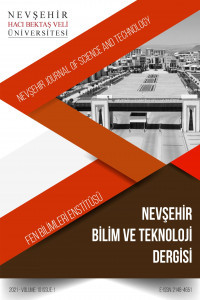Boraksın (Na2O2B2O3.10H2O) Tenebrio mollitor (Coleoptera: Tenebrionidae) Üzerindeki LC50 Değerinin Belirlenmesi ve Boraksın Subletal Dozlarının Un Kurdu Larvaları Üzerindeki Toksik Etkilerinin Belirlenmesi
Giemsa, Tenebrio mollitor, Hemosit, Larval ağırlık, Tenebrio mollitor
Determination of LC50 Value of Borax (Na2O2B2O3.10H2O) on Tenebrio mollitor (Coleoptera: Tenebrionidae) and Determination Toxic Effects of Sublethal Doses of Borax on Mealworm Larvae
Borax, Giemsa, Hemocyte, Larval weight, Tenebrio mollitor,
___
- [1] Collins, L., Edwards, L., “Toxicity of moist snuff and impact on various stages of darkling beetles (Tenebrio molitor)”, Explorations, Biology and Biotechnology, 2017. [2] Berger, J., Slavickova, K., “Morphological characterization of hemocytes in the adult Linden Bug, Pyrrhocoris apterus (L.) (Heteroptera), Zoological Studies, 47(4): 466-472, 2008. [3] Gupta, A.,P., “Hemocyte types: their structures, synonymies, interrelationships, and taxonomic significance”, In AP Gupta, ed. Insect hemocytes, New York: Cambridge University Press, 85-127, 1979. [4] Anonima, “Kimya Borsası”, http://www.kimyaborsasi.com.tr/b/boraks-27.html, 2017. [5] Sağlam, M., Köseoğlu, S., Enhoş, Ş., “Periodontolojide bor”, Sağlık Bilimleri Dergisi (Journal of Health Sciences, 22(1), 70-75, 2013. [6] Anonimb, “Boric acid, human and environmental risk assessment on ingredients of household cleaning products”, HERA, 2-81, 2005. [7] Parlak, H., Arslan Çakal, Ö., Boyacığlu, M., Karaarslan, A.M., “Ekotoksikoloji”, Ege Üniversitesi Basımevi, 63, 2009. [8] Qiang, X., Hongxia, S., Yinghua, S., Dexiang, U.G., Zhang, G., “Apoptosis of Spodoptera litura larval hemocytes induced by heavy metal zinc”, Chinese Science Bulletin, 50(24), 2856-2860, 2005. [9] Coşkun, G., Özgür, H., “Molecular mechanism of apoptosis and necrosis”, Archives Medical Review Journal, 20(3), 145-158, 2011. [10] Üstüner, D., “Kromozom kırıkları ve mikronükleus-apoptoz bağlantısı”, Tübav Bilim Dergisi, 4, 64-69, 2011. [11] Patil, B.S., Magdum, S.C., “Determination of LC50 values of extracts of Euphorbia hirta Linn and Euphorbia neriifolia Linn using brine shrimp lethality assay”, Asian Journal of Pharmaceutical Sciences, 1, 2, 42-43, 2011. [12] Anonimc, “Acute toxicity,”, http://www.ilo.org/legacy/english/protection/safework/ghs/ghsfinal/ghsc05.pdf, 2017. [13] Pongsavee, M., “Genotoxic effects of borax on human lymphocytes”, Southeast Asian Journal of Tropical Medicine and Public Health, Bangkok, 40, 2, 411-8, 2009. [14] Büyükgüzel, K., Büyükgüzel, E., “İnsan çevre ve tarım açısından borik asitin zararlı böceklerin ve diğer artropodların mücadelesindeki önemi”, Zonguldak Karaelmas Üniversitesi, Avrupa Birliği 6. Çerçeve Programı kapsamında II. Bor Çalıştayı, Zonguldak, 2004 [15] Sak, O., Uçkan, F., “Cypermethrinin Galleria mellonella L. (Lepidoptera: Pyralidae)’nın puplaşma ve ölüm oranına etkisi, Uludağ Arıcılık Dergisi, 9 (3), 88-96, 2009. [16] Konuk, M., Liman, R., Ciğerci, H.İ., “Determination of genotoxic effect of boron on Allium cepa root meristematic cell”, Pakistan Journal of Botanic, 39(1), 73-79, 2007. [17] Jolly, W.L., “Modern inorganic chemistry”, 2nd Ed. McGraw-Hill, New York, 1991. [18] Diplock, A., “Healty lifestyles nutrition and physical activity: antioxidant nutrients”, ILSI Europe Concise Monograph Series, 59, 1998. [19] Palupi, M.R., Andayani, S., Fadjar, M., “Bioaccumulation of heavy metal zinc (Zn) and copper (Cu) and histology of grouper (Epinephelus Suilus) in coastal panceng waters Of Gresik regency. Journal of Scientıfıc & Technology Research, 5(1), 2277-8616, 2016. [20] Jesus D., Silva-Zacarin, E.C.M., Malaspina, O., “Histological studies in the midgut and malpighian tubules of Apis mellifera workers treated with boric acid”, Brazilian Journal of Morphological Sciences, 22, 168, 2005. [21] Malaspina, O., Mathias, C.E., Zacarin, S., “Cell markers for ecotoxicological studies in target organs bees”, Brazilian Journal of Morphological Sciences, 23(3-4), 303-309, 2006. [22] Wei, Y., Yuan, J.F., Zhou, B.W., Wu, L., Chen, L., Wang, J.J., Zhang, S.Y., “Borax-induced apoptosis in HepG2 cells involves p53, Bcl-2, and Bax”, Genetics and Molecular Research, 15 (2), 1-10, 2016. [23] Sylvain, I.C., Berry J.P., Galle P., “Ultrastructural apoptotic lesions induced in rat thymocytes after borax ingestion”, Anticancer Res, 18, 2455-61, 1998. [24] Altunkaynak, Z.B., Özbek, E., “Programlanmış Hücre Ölümü: Apoptoz Nedir?”, Tıp Araştırmaları Dergisi”, 6 (2), 93 -104, 2008. [25] Şekeroğlu, V., Atlı-Şekeroğlu, Z., “Genotoksik hasarın belirlenmesinde mikronükleus testi, Türk Hijyen ve Deneysel Biyoloji Dergisi, 68(4), 241 – 252, 2011. [26] Plata-Rueada, A., Martinez, C.L., Santos, D.H.M., Fernandes, L.F., Wilcken, F.C., Soares, A.M., Serrao, E.C., Zanunciob, C.J., “Insecticidal activity of garlic essential oil and their constituents against the mealworm beetle, Tenebrio molitor Linnaeus (Coleoptera: Tenebrionidae), Scientific Reports, 7, 46406, 2017.
- ISSN: 2148-466X
- Yayın Aralığı: Yılda 2 Sayı
- Başlangıç: 2012
- Yayıncı: Nevşehir Hacı Bektaş Veli Üniversitesi
Ege Kıyıları (Edremit Körfezi-Gökova Körfezi Arası)’nın Florası
Türkiye’de İnşaat Sanayi Sektörünün Gelişimi-Temel İnşaat Sanayi Göstergeleri
Erdem KOÇ, Kadir KAYA, Mahmut Can ŞENEL
Bitki Patojeni Virüslerin Nanoteknolojide Kullanımı
Hatice Diğdem OKSAL, Fatih ÖRS
Serkan DAL, Cemal ÇARBOĞA, Bülent KURT
Kısa Ömürlü Ürünlerin Tedarik Zincirinin Modellenmesi ve Simülasyon Çalışması
İbrahim DOĞAN, Ahmet TEKKEŞİN, Ahmet KARA
Nevşehir Pomza Endüstrisi’nin Genel Değerlendirilmesi
Ahmet ORHAN, İsmail DİNÇER, Mutluhan AKIN, Serap ÇOBAN
